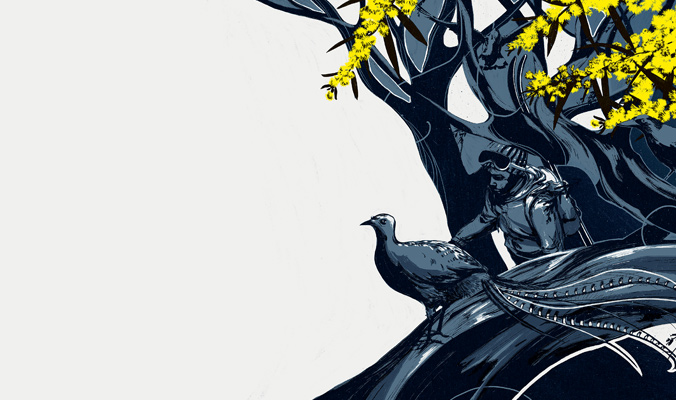
Illustration by Pat Kinsella
I step outside to a dazzling sky heavy with stars. Above spins Centaurus, Vela and the Southern Cross. The pale glow in the east tells me I’m an hour late. Too close to dawn. The animals will be moving soon.
I head off, crossing the low divide out to the highway. On the bends, kangaroos move from nighttime feeding spots, and smaller wallabies give me a fright as they dart in front of the car. I head out to the main road and over the Cobaw Ranges. This time it’s wombats, gliders and possums. My knuckles turn white from clutching the wheel as I scan for kamikaze animals appearing from nowhere. Luckily, there are no collisions and I make it up the Goulburn River Valley. Finally, mountains appear as a long wall of crumpled peaks.
My heart jumps. There’s more snow than I expected, covering the summits of Mt. Stirling, the west ridge of Buller and the high edge of The Bluff. Closer to the mountains, I follow the Delatite River, which runs fast with snowmelt, and then, finally, starting up the mountain itself and into the alpine ash forest.
At Telephone Box Junction, I park the car, shoulder my pack and start the slow climb up Bluff Spur toward Mt. Stirling. Silent mist sweeps around the spot where strange stones sit among alpine ash trees. It’s a special place of the Yowung-illum-balluk—the “stone-dwelling people” of the Taungurung tribe, part of the Kulin nation, whose land stretches all the way to the coast. I hurry past the stones, nod my head, wonder if the old spirits still guard this place.
Up the trail, a lyrebird—a secretive and beautiful bird of the wet forests—stands on the track. It stares me down, then scratches slowly and arcs back into the trees. The gate has been opened and I’m welcome on Mt. Stirling.
The understory is a mad rush of color as the wattles bloom in sprays of yellow. High above, over the valley, the ski resort sits emptied of winter crowds. In a distance, currawongs call as I enter the transition from ash to snow gum; wonderful, lyrical trees with pale trunks.
At snowline, sheets of bark and thousands of small stones cover crusty spring corn. I look closer. It’s not stones but the chewed-over flower heads of the snow gums. Higher, a gang of yellow-tailed black cockatoos sits in the crown of a tree, shredding seed heads and casually talking to and fro, like old guys on the porch.
I click on my skis and for the last few kilometres to treeline, I hear the reassuring creak of bindings and slough of skins. It all opens out: the Cross Cut, Speculation, Buffalo, across to The Bluff. There’s a distant smudge of white where Feathertop and Bogong hold winter. Beyond Bogong sits the Main Range of the Snowy Mountains. My country. The distant plains far below are already turning gray-brown as the grass dries. I imagine the curve of the earth and the great flatness to the north, to the top of Australia. I think of the fleeting beauty and miracle of snow on a hot, old, dry and flat continent.
Ripping skins, I stand on the edge of Stanley Bowl, which faces southeast and, in the spring, holds snow all the way into the trees. I think of the times in these hills, of storms and rain, lightning and powder and gaze down on catchments, logging cuts, rocky ridgelines and fuzzy scars of wildfire. Soon summer will be here with hot nights swimming in the Res, the taste of dust in the air, fire season and the struggle to keep the garden alive.
I shuffle to the edge, cut those first turns, focusing on my stance, dodging rocks, following lines of fresher snow. One last set of turns marks another winter, another cycle around the sun.
I come to a final leg-shuddering stop among the trees. Once at the dirt, I take my skis off and prepare for the long climb out of winter and into what’s next. I’m ready.











Related posts:
Mountain Skills: Planning a trip to an offbeat location requires more than Google
The Wild, Wild South: How a handful of South American countries are reshaping guiding and avalanche …
Ryan Koupal’s 40 Tribes Backcountry offers Asia’s most exotic yurt trips
The Seventh Sojourn: It’s impermissible to ski on Kilimanjaro. Will it soon be impossible?